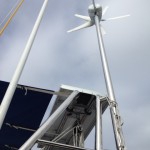My sail selection experience is from one design boats where the conversation with the sailmaker is “Can I have a new set of class legal sails please”. There is no choice of size or material since that is dictated by the class rules. But on a cruising cat you can fly anything your heart desires off the mast head from screechers to grand pa’s old underpants.
Main Sail 606 sq ft : We added two reefing blocks sewn into the leech of the main to reduce friction and make reefing the main easier. This will work very well with the in-boom reefing system that comes standard on the boat. You can see them if you look closely at the mainsail on 4439. They are a bit pricey but look to be very useful when reefing alone. Sailcloth choice is the trade off between speed, durability and how much abuse the sail can take. Typically laminate sails are considered faster out of the bag since they can hold a shape better than a classic dacron sail. The Antares main is now standard in NORLAM and we stayed with the standard.
Genoa 472 sq ft: Older laminate sails were more susceptible to mold growing between the two laminations. The ugly brown stains look like dirty sails but no manner of scrubbing will remove the spots as its a suburban mold family living in the middle of the sail. They will laugh as you scrub. To prevent this, one can make sure the sails dry properly after use and use chemical sprays. So the downside of laminate is mold and the upside is maybe better sail shape. We chose the laminate for reasons of vanity. Two grey sails will look cool but now we have to fret about a moldy genoa. I have blogged this so I can come back to rue this choice.
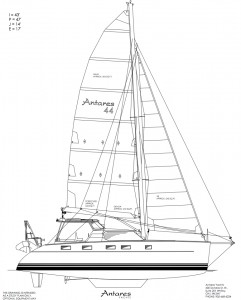
Antares Sail Plan
JIB 243 sq ft: We did deviate from the standards for the self taking jib. It is made from Nordac a non laminate dacron sail. Bullet proof.
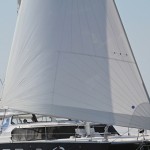
Screecher
Screecher 635 sq ft: Again no change to the factory standard. Was advised by North Sails that this sail should be stowed when expecting rough weather as it can unfurl at the wrong times. Also it should be stowed when sitting at anchor for long periods to protect it against sun damage. Many owners have not followed this advice for 5 years and have been just fine. I plan on taking heed but it is nice to know that the sail is so well built. Damage to the screecher can occur when flying it in stronger winds while close to the wind. The following is a table which Antares produces as a guide.
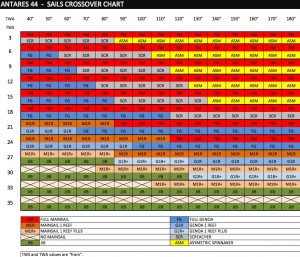
Sail Selection Table
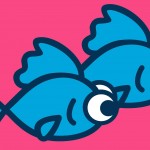
Chute Logo
Asymmetric Spinaker: Antares owners before have gone with three choices. No chute, Asym by North or a Parasailor from a South African company. We chose the 1,200 sq foot asymmetric to keep it simple stupid. Out chute will be hot pink with a Two Blue Fish logo (see left). The luff of the sail will be built with a heavier cloth to assist carrying the sail a few degrees too hot.
Plenty of owners enjoy the Parasailor and it is impossible for me to comment since I have not tried flying this new type of chute. Its selling point is a vented wing in the middle of the chute that aids in flying and acts as a release valve. I stuck with old school. I can tell you the name needs improvement as it sounds like an almost-sail and Google searches give you plenty of places to go parasailing behind a motor boat.

